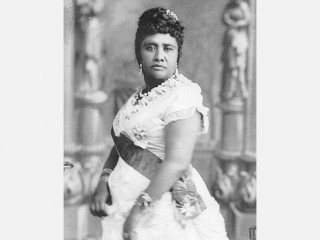
Queen Liliuokalani biography
Date of birth : 1838-09-12
Date of death : 1917-11-11
Birthplace : Honolulu, Hawaii, United States
Nationality : Hawaian
Category : Historian personalities
Last modified : 2010-07-15
Credited as : Queen of the Hawaiian Kingdom, ,
20 votes so far
Lydia Kamakaeha Liliuokalani, last ruler of the Hawaiian Kingdom, was deposed in 1893 after attempting to wrest Hawaii from foreign influence.
Lydia Liliuokalani was born on Sept. 12, 1838, in Honolulu of a family of high chiefs. She was educated at the Chiefs' Children's School, under the discipline of missionary teachers. At the age of 24 she married John O. Dominis, son of a Boston sea captain. The couple lived part of the time at Washington Place, which later became the home of Hawaii's governor.
When her brother Kalakaua came to the throne in 1874, Princess Liliuokalani became prominent in the social life of his court. She had talent as a poet and musician and in 1878 composed "Aloha Oe" (Farewell to Thee), still one of Hawaii's best-loved songs. During Kalakaua's absence on a world tour in 1880-1881, Liliuokalani served as regent. She also accompanied Kalakaua's queen, Kapiolani, to England to Queen Victoria's Golden Jubilee in 1887.
On her return, Liliuokalani found that King Kalakaua had been forced to sign a new constitution that took away much of his power. When he died in 1891 while on a trip to the United States, Liliuokalani was proclaimed queen.
Liliuokalani's accession came at a time of economic distress and political unrest. Annexationist sentiment was high among American residents of Hawaii. In January 1893 the Queen tried to proclaim a new constitution that would return power to the throne. The annexationists quickly overthrew her, after the United States minister to Hawaii had landed troops "only to protect American life and property." The Queen yielded under protest, hoping the United States would restore her to the throne. After investigation, President Grover Cleveland tried this, but it proved a hopeless task. The annexationists rightly guessed that Cleveland would not use guns to force the restoration of Liliuokalani, and they refused to yield power.
In 1894 annexationists formed the Republic of Hawaii. Six months later they quickly put down an insurrection in which Liliuokalani was implicated. Thereafter, she gave up her claim to the throne, swore allegiance to the republic, and announced her intention to live quietly as a private citizen.
Though Hawaii became a territory of the United States in 1898, Liliuokalani still ruled in the hearts of her people. When she died in Honolulu on Nov. 11, 1917, she was given a magnificent state funeral.
















